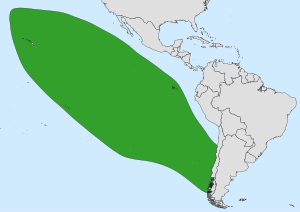Juan Fernández petrel facts for kids
Quick facts for kids Juan Fernández petrel |
|
|---|---|
 |
|
| Conservation status | |
| Scientific classification | |
| Genus: |
Pterodroma
|
| Species: |
externa
|
 |
|
The Juan Fernández petrel (scientific name: Pterodroma externa) is a type of seabird. It belongs to a group of birds called Procellariidae, which includes petrels and shearwaters. This special bird makes its nests on just one island near Chile. This island is part of the Juan Fernández Archipelago. Long ago, some people thought it was a different kind of petrel, called the white-necked petrel.
Contents
About the Juan Fernández Petrel
The Juan Fernández petrel is a large gadfly petrel. It measures about 43 cm (17 in) long. Its wings can spread out to 95–97 cm (37–38 in) wide. This bird weighs around 500 g (1.1 lb).
What It Looks Like
Its back and top parts are dark brownish-grey. When its wings are spread, you can see a black M-shaped mark. The bird's belly and underside are white. The underside of its wings has black edges.
Its face is white, but it has a black "cap" that goes down past its eyes. Its feet are yellow, with dark brown tips. The beak is black and has a hooked end. Like other Procellariiformes, it has special tube-shaped nostrils on its beak.
Life Cycle and Breeding
Juan Fernández petrels build their nests high up on ridges. These nesting spots are usually above 750 m (2,460 ft). They dig a burrow that can be 2–3 m (6 ft 7 in – 9 ft 10 in) long. Each year, they raise one chick in this burrow.
Raising a Chick
Female petrels lay a single white egg in mid-November. Both parents take turns sitting on the egg. This incubation period lasts about 60 days. The chick hatches in mid-February.
Both parents feed the chick for 90 to 100 days. The chick stays underground in the burrow. It remains there until it is fully feathered and big enough to fly. Young petrels are fed mostly fish and squid that their parents bring back.
Where They Live and Their Status
During the breeding season, these petrels look for food in the waters around Isla Alejandro Selkirk and Isla Robinson Crusoe. Both islands are in the Juan Fernández Archipelago. They also forage near the coast of Chile. You might see them flying in groups with other seabirds, like pink-footed shearwaters.
When it's not breeding season, the petrels fly far north. They can be found in ocean currents near the equator, even as far as the Hawaiian Islands. Sometimes, a few birds have been seen in places like Australia, New Zealand (Chatham Islands), Fiji, and even in the United States (Arizona and Oregon).
Conservation Status
The Juan Fernández petrel only breeds on one island: Isla Alejandro Selkirk in Chile. In the mid-1980s, scientists thought there were about 1 million breeding pairs. Globally, there might be 3 to 5 million of these birds.
However, the petrels face threats at their nesting sites. Cats and rats, which were brought to the island, hunt the birds. Goats, also introduced, cause some habitat loss by eating plants. Because it nests on only one island and faces these dangers, the IUCN Red List lists the species as vulnerable. This means it needs protection to survive.
See also
 In Spanish: Petrel de Juan Fernández para niños
In Spanish: Petrel de Juan Fernández para niños


